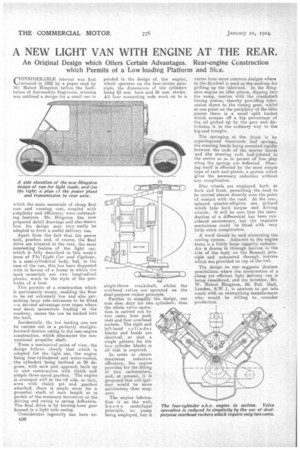A NEW LIGHT VAN WITH ENGINE AT THE REAR.
Page 20

If you've noticed an error in this article please click here to report it so we can fix it.
An Original Design which Offers Certain Advantages. Rear-engine Construction which Permits of a Low loading Platform and Sice.
CONSIDERABLE interest was first aroused in 1922 by a paper read by Halcot Hingston before the Institution of Automobile Engineers, wherein was outlined a design for a small car in
which the main essentials of cheap first cost and running cost, coupled with simplicity and efficiency, were outstanding features. Mr. Hingston has now prepared detail drawings and also shown how his design may very easily be adapted to fcirm a useful delivery van.
Apart from the fact that the power unit, gearbox and, of course, the final drive are situated at the rear, the most interesting feature of the light car, which is fully described in this week' issue of The Light Car and Cyclecar, is a semi-cylindrical body, but, M the case of the van, this has been dispensed with in favour of a frame in which the main essentials are two longitudinal planks, much in the style of the gunwales of a boat.
This permits of a. construction which is particularlyroomy, enabling the floor to tie set extremely low and also permitting large side entrances to be fitted —a decided advantage over types where end doors necessitate loading in the roadway, unless the van be backed into the kerb.
Incidentally, the low loading line can be carried out in a perfectly straightforward fashion owing to the rear-engine construction, which eliminates the conventional propeller shaft.
From a mechanical point of view, the design follows closely that which is adopted for the light car, the engine being founcylindered and water-cooled, the cylinders being inclined at 90 degrees, with each pair opposed, built up in unit construction -with clutch and simple three-speed gearbox. The engine is arranged well to the off side, so that, even with clutch pit and gearbox attached, there is ample mnni for a propeller shaft of such length as to permit of the necessary movement at the driving end owing to spring deflection. The final drive is by herring-bone gear housed in a light axle casing.
Considerable ingenuity has been exC36 pended in the design of the engine, which operates on the four-stroke principle, the dimensions of the cylinders being 63 mm. bore and 96 mm. stroke. Al] four connecting rods work on to a single-throw crankshaft, whilst the overhead valves are operated on the dual-purpose rocker principle.
In order to obtain maximum induction efficiency, the engine provides for the fitting of two carburetters, and, at present, it is proposed that coil ignition would be more satisfactory than magneto.
The engine lubrication is on the wellknown centrifugal principle, no pump being employed, but it varies from more common designs-where in the flywheel is used as the medium fot picking up the lubricant. In the Ringston engine an idler pinion, dipping into the sump, meshes with the crankshaft timing pinion, thereby providing lubrication direct to the timing gear, whilst at one point on the periphery of the idler pinion there is a small split bucket which scrapes off a big percentage of the oil picked up by the gear and distributes it in the ordinary way to the big-end troughs.
The springing at the front is by superimposed transverse leaf springs, the steering heads being mounted rigidly between the ends of the master leaves and the ;steering rods ball-jointed in the centre so as to permit of free play when the springs are deflected. Steering itself is effected by the most simple type of rack and pinion, a system which gives the necessary reduction without any complication.
Disc wheels are employed both at back and front, permitting the load to be carried almost directly over the point of contact with the road. At the rear, splayed quarter-elliptics are utilized which take both torque and riving strains. It will be scan that the introduction of a differential has been considered unnecessary, but the requisite mechanism could be fitted With very little extra complication.
A word should be said concerning the cooling system. Adjacent to the engine there is a fairly large capacity radiator. Air is draWn in through louvres in the side of the body on the Renault principle and exhausted through louvres which are provided on top of the tail.
The design in. tofo suggests distinct possibilities-where the construction of a cheap yet effieient light delivery van is being considered, and the inventiar, Mr. W. Halcot Hingston, .50, Pall Mall, London, S.W. 1, is. anxious to get into touch with an enterprising manufacturer who would be willing to consider production.




























